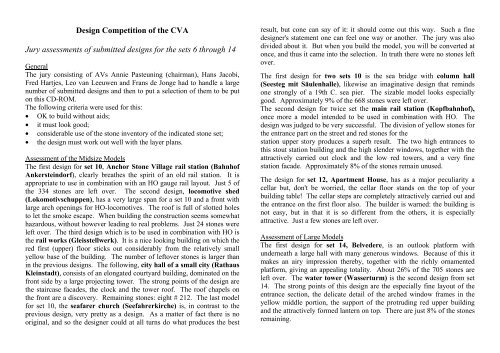Bauvorlagen 10, 12, 14 - Aktuell - ankerstein.ch
Bauvorlagen 10, 12, 14 - Aktuell - ankerstein.ch
Bauvorlagen 10, 12, 14 - Aktuell - ankerstein.ch
Create successful ePaper yourself
Turn your PDF publications into a flip-book with our unique Google optimized e-Paper software.
Design Competition of the CVA<br />
Jury assessments of submitted designs for the sets 6 through <strong>14</strong><br />
General<br />
The jury consisting of AVs Annie Pasteuning (<strong>ch</strong>airman), Hans Jacobi,<br />
Fred Hartjes, Leo van Leeuwen and Frans de Jonge had to handle a large<br />
number of submitted designs and then to put a selection of them to be put<br />
on this CD-ROM.<br />
The following criteria were used for this:<br />
• OK to build without aids;<br />
• it must look good;<br />
• considerable use of the stone inventory of the indicated stone set;<br />
• the design must work out well with the layer plans.<br />
Assessment of the Midsize Models<br />
The first design for set <strong>10</strong>, An<strong>ch</strong>or Stone Village rail station (Bahnhof<br />
Ankersteindorf), clearly breathes the spirit of an old rail station. It is<br />
appropriate to use in combination with an HO gauge rail layout. Just 5 of<br />
the 334 stones are left over. The second design, locomotive shed<br />
(Lokomotivs<strong>ch</strong>uppen), has a very large span for a set <strong>10</strong> and a front with<br />
large ar<strong>ch</strong> openings for HO-locomotives. The roof is full of slotted holes<br />
to let the smoke escape. When building the construction seems somewhat<br />
hazardous, without however leading to real problems. Just 24 stones were<br />
left over. The third design whi<strong>ch</strong> is to be used in combination with HO is<br />
the rail works (Gleisstellwerk). It is a nice looking building on whi<strong>ch</strong> the<br />
red first (upper) floor sticks out considerably from the relatively small<br />
yellow base of the building. The number of leftover stones is larger than<br />
in the previous designs. The following, city hall of a small city (Rathaus<br />
Kleinstadt), consists of an elongated courtyard building, dominated on the<br />
front side by a large projecting tower. The strong points of the design are<br />
the staircase facades, the clock and the tower roof. The roof <strong>ch</strong>apels on<br />
the front are a discovery. Remaining stones: eight # 2<strong>12</strong>. The last model<br />
for set <strong>10</strong>, the seafarer <strong>ch</strong>ur<strong>ch</strong> (Seefahrerkir<strong>ch</strong>e) is, in contrast to the<br />
previous design, very pretty as a design. As a matter of fact there is no<br />
original, and so the designer could at all turns do what produces the best<br />
result, but cone can say of it: it should come out this way. Su<strong>ch</strong> a fine<br />
designer's statement one can feel one way or another. The jury was also<br />
divided about it. But when you build the model, you will be converted at<br />
once, and thus it came into the selection. In truth there were no stones left<br />
over.<br />
The first design for two sets <strong>10</strong> is the sea bridge with column hall<br />
(Seesteg mit Säulenhalle), likewise an imaginative design that reminds<br />
one strongly of a 19th C. sea pier. The sizable model looks especially<br />
good. Approximately 9% of the 668 stones were left over.<br />
The second design for twice set the main rail station (Kopfbahnhof),<br />
once more a model intended to be used in combination with HO. The<br />
design was judged to be very successful. The division of yellow stones for<br />
the entrance part on the street and red stones for the<br />
station upper story produces a superb result. The two high entrances to<br />
this stout station building and the high slender windows, together with the<br />
attractively carried out clock and the low red towers, and a very fine<br />
station facade. Approximately 8% of the stones remain unused.<br />
The design for set <strong>12</strong>, Apartment House, has as a major peculiarity a<br />
cellar but, don't be worried, the cellar floor stands on the top of your<br />
building table! The cellar steps are completely attractively carried out and<br />
the entrance on the first floor also. The builder is warned: the building is<br />
not easy, but in that it is so different from the others, it is especially<br />
attractive. Just a few stones are left over.<br />
Assessment of Large Models<br />
The first design for set <strong>14</strong>, Belvedere, is an outlook platform with<br />
underneath a large hall with many generous windows. Because of this it<br />
makes an airy impression thereby, together with the ri<strong>ch</strong>ly ornamented<br />
platform, giving an appealing totality. About 26% of the 705 stones are<br />
left over. The water tower (Wasserturm) is the second design from set<br />
<strong>14</strong>. The strong points of this design are the especially fine layout of the<br />
entrance section, the delicate detail of the ar<strong>ch</strong>ed window frames in the<br />
yellow middle portion, the support of the protruding red upper building<br />
and the attractively formed lantern on top. There are just 8% of the stones<br />
remaining.






